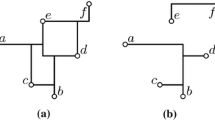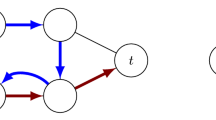Abstract
A feed-link is an artificial connection from a given location p to a real-world network. It is most commonly added to an incomplete network to improve the results of network analysis, by making p part of the network. The feed-link has to be “reasonable”, hence we use the concept of dilation to determine the quality of a connection.
We consider the following abstract problem: Given a simple polygon P with n vertices and a point p inside, determine a point q on P such that adding a feedlink \(\overline{pq}\) minimizes the maximum dilation of any point on P. Here the dilation of a point r on P is the ratio of the shortest route from r over P and \(\overline{pq}\) to p, to the Euclidean distance from r to p. We solve this problem in O(λ 7(n)logn) time, where λ 7(n) is the slightly superlinear maximum length of a Davenport-Schinzel sequence of order 7. We also show that for convex polygons, two feed-links are always sufficient and sometimes necessary to realize constant dilation, and that k feed-links lead to a dilation of 1 + O(1/k). For (α,β)-covered polygons, a constant number of feed-links suffices to realize constant dilation.
This research has been supported by the Netherlands Organisation for Scientific Research (NWO) under BRICKS/FOCUS grant number 642.065.503, under the project GOGO, and under project no. 639.022.707. B. Aronov has been partially supported by a grant from the U.S.-Israel Binational Science Foundation, by NSA MSP Grant H98230-06-1-0016, and NSF Grant CCF-08-30691. M. Buchin is supported by the German Research Foundation (DFG) under grant number BU 2419/1-1.
Preview
Unable to display preview. Download preview PDF.
Similar content being viewed by others
References
Agarwal, P., Sharir, M., Shor, P.: Sharp upper and lower bounds on the length of general Davenport-Schinzel sequences. Journal of Combinatorial Theory, Series A 52, 228–274 (1989)
Aronov, B., Buchin, K., Buchin, M., Jansen, B., de Jong, T., van Kreveld, M., Löffler, M., Luo, J., Silveira, R.I., Speckmann, B.: Feed-links for network extensions. In: Proc. 16th International Symposium on Advances in Geographic Information Systems, pp. 308–316 (2008)
Bose, P., Dujmović, V.: A note on the perimeter of (α, β)-covered objects (manuscript, 2009)
de Berg, M.: Linear size binary space partitions for uncluttered scenes. Algorithmica 28, 353–366 (2000)
de Berg, M., van der Stappen, A., Vleugels, J., Katz, M.: Realistic input models for geometric algorithms. Algorithmica 34, 81–97 (2002)
de Jong, T., Tillema, T.: Transport network extensions for accessibility analysis in geographic information systems. In: Proc. AfricaGIS (2005)
Ebbers-Baumann, A., Grüne, A., Klein, R.: The geometric dilation of finite point sets. Algorithmica 44, 137–149 (2006)
Efrat, A.: The complexity of the union of (α, β)-covered objects. SIAM Journal on Computing 34, 775–787 (2005)
Erickson, J.: Local polyhedra and geometric graphs. Computational Geometry: Theory and Applications 31, 101–125 (2005)
Farshi, M., Giannopoulos, P., Gudmundsson, J.: Finding the best shortcut in a geometric network. In: Proc. 21st Symposium on Computational Geometry, pp. 327–335 (2005)
Guibas, L.J., Hershberger, J., Leven, D., Sharir, M., Tarjan, R.E.: Linear-time algorithms for visibility and shortest path problems inside triangulated simple polygons. Algorithmica 2, 209–233 (1987)
Hershberger, J.: Finding the upper envelope of n line segments in O(n logn) time. Information Processing Letters 33, 169–174 (1989)
Langerman, S., Morin, P., Soss, M.: Computing the maximum detour and spanning ratio of planar paths, trees, and cycles. In: Alt, H., Ferreira, A. (eds.) STACS 2002. LNCS, vol. 2285, pp. 250–261. Springer, Heidelberg (2002)
Narasimhan, G., Smid, M.: Approximating the stretch factor of Euclidean graphs. SIAM Journal on Computing 30, 978–989 (2000)
Narasimhan, G., Smid, M.: Geometric Spanner Networks. Cambridge University Press, Cambridge (2007)
Sharir, M., Agarwal, P.: Davenport-Schinzel Sequences and Their Geometric Applications. Cambridge University Press, Cambridge (1995)
van der Stappen, A.F., Overmars, M.H., de Berg, M., Vleugels, J.: Motion planning in environments with low obstacle density. Discrete & Computational Geometry 20, 561–587 (1998)
van Kreveld, M.: On fat partitioning, fat covering and the union size of polygons. Computational Geometry: Theory and Applications 9, 197–210 (1998)
Author information
Authors and Affiliations
Editor information
Editors and Affiliations
Rights and permissions
Copyright information
© 2009 Springer-Verlag Berlin Heidelberg
About this paper
Cite this paper
Aronov, B. et al. (2009). Connect the Dot: Computing Feed-Links with Minimum Dilation. In: Dehne, F., Gavrilova, M., Sack, JR., Tóth , C.D. (eds) Algorithms and Data Structures. WADS 2009. Lecture Notes in Computer Science, vol 5664. Springer, Berlin, Heidelberg. https://doi.org/10.1007/978-3-642-03367-4_5
Download citation
DOI: https://doi.org/10.1007/978-3-642-03367-4_5
Publisher Name: Springer, Berlin, Heidelberg
Print ISBN: 978-3-642-03366-7
Online ISBN: 978-3-642-03367-4
eBook Packages: Computer ScienceComputer Science (R0)




